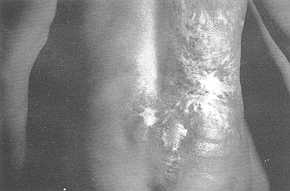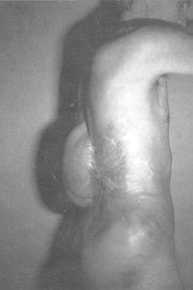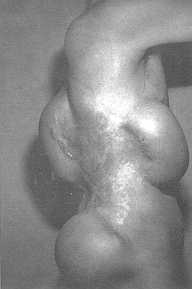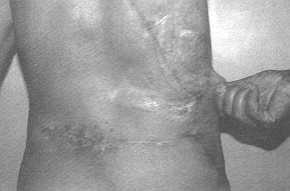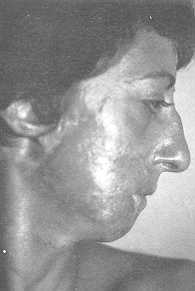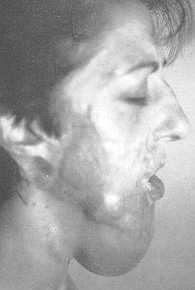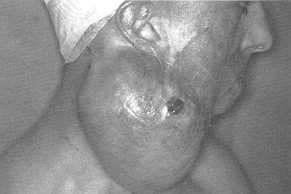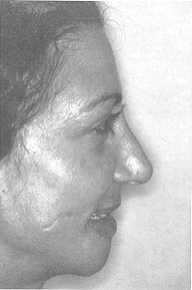Annals of the MBC - vol. 3 - n'3 - September 1990 TISSUE EXPANSION IN THE TREATMENT OF BURN SCARSCaleffi E, Bocchi A., Toschi S., Montacchini G., Papadia F. Divisione di Chirurgia Plastica, Parma, Italia SUMMARY. Major post-burn scars are a serious morphological and functional problem and old techniques like skin grafts and distant flaps are not very effective to improve the final result. Expansion of the local skin allows us to obtain very large local flaps and the replacement of the scar tissue with a good skin for colour and texture. We have used the tissue expansion technique in the treatment of burn scars in the head and neck, trunk, upper and lower extremities. In the head and neck, tissue expansion is useful to obtain good results but the complication rate is higher than in the treatment of other pathologies with the same technique. Good results are obtained in the back where very large amounts of scarred tissue can be removed. In the thorax the morphological results are less satisfactory because of the hypertrophic scars resulting after the operation. In the thigh a good cosmetic improvement has very often been achieved; in the leg, on the contrary, we have observed the highest rate of complications: the use of tissue expansion in this area must be very careful and limited to selected cases. In the last few years tissue expansion has improved thanks to technical refinements in plastic surgery. In the past, the treatment of bum scars was carried out by the use of skin grafts or the transposition of local flaps. With skin grafts recurrence of contracture, chronic breakdowns and unsatisfactory cosmetic outcomes were observed; local flaps may be insufficient to resurface large defects after debridement or excision of a post-bum scar. Expansion of the local skin makes it
possible to obtain very large local flaps and to replace a great amount of scar tissue
with a good skin for colour and texture (Argenta, 1985; Chang, 1986; Cohen 1988; Manders,
1984; Nordstrom, 1985; Radovan, 1979). Case report 1 (Fig. 1) A 48-year-old man had sustained a burn of the back 23
years previously. In recent years he observed a recurrent ulceration in the centre of the
scar. A biopsy did not show malignant cells but the recurrence of chronic breakdown was an
indication for surgical excision of the scar tissue. In the first operation two tissue
expanders were placed; one (1200 cc) was inserted in the paravertebral area and the other
(1700 cc) in the right gluteal region. Two months later partial removal of the scar
including the ulcerated area and reconstruction with the expander flap were performed. A
re-expansion was performed one year later and 3 tissue expanders were placed at gluteal
and lateral the level of the paravertebral thoracic regions. Case report 2 (Fig. 2) A 32-year-old woman had sustained a
bum of the face, neck and upper extremities at the age of six months. Scar and
contractures of the cheek and oral region were inacceptable for the patient. Discussion In our series tissue expansion has
yielded satisfactory results if compared with old techniques such as skin grafts or local
flaps. However, the tissue expansion complication rate is higher in the treatment of large
post-burn scars than in the treatment of other pathologies such as haemangiomas, giant
naevi, post-mastectomy defects, bone exposure, etc.
Excellent results have been obtained in the back, where
very large amounts of scarred tissue can be removed in a single operation; re-expansion is
also reliable and very useful to perform removal of scars.
On the basis of our experience, tissue expansion is undoubtedly a method of choice in the treatment of post-burn scars; expansion must by very careful where stiffness of the tissue or terminal vascularization is present (leg, finger). At the level of the knee, elbow and neck, a very large amount of expanded skin is always necessary to carry out adequate reconstruction. RÉSUMÉ. Les cicatrices étendues causées par les brûlures constituent un grave problème morphologique et fonctionnel et les techniques utilisées par le passé, comme par exemple les greffes cutanées et les lambeaux à distance, ne réussissent pas à améliorer le résultat final. Les Auteurs ont utilisé la technique de l'expansion tissulaire dans le traitement des cicatrices causées par les brûlures à la tête, au cou et aux extrémités supérieures et inférieures. A la tête et au cou l'expansion tissulaire permet d'obtenir de bons résultats, même si le taux des complications est plus haut par rapport au traitement, avec la même technique, des autres pathologies. Il est aussi possible d'obtenir de bons résultats au dos parce que de grandes quantités de tissu cicatrisé peuvent être enlevées. Au thorax les résultats morphologiques sont moins satisfaisants à causes des cicatrices hypertrophiques qui sur-viennent à la suite de l'acte opératoire. A la cuisse on peut obtenir une bonne amélioration cosmétique; à la jambe, au contraire, on observe le taux plus haut des complications: dans cette partie du corps l'expansion tissulaire doit être effectuée avec grande attention et seulement chez des patients sélectionnés. BIBLIOGRAPHY
|
